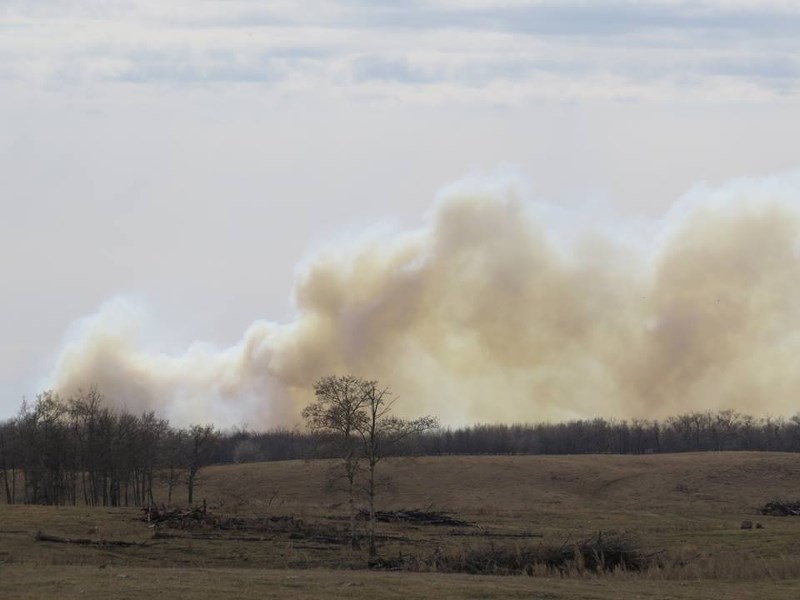Local firefighters had their work cut out for them last week, as dry conditions and high winds whipped up a blaze at the local grazing reserve that St. Paul Fire Chief Trevor Kotowich described as a significant challenge.
“It was a very large fire. In my 25 years, it was one of the larger fires we’ve seen, there was so much land that had been burning,” he said, with more than 3,000 acres having been estimated as burned.
The grazing reserve fire kept local crews at work over the course of two eventful days.
Dennis Bergheim, fire guardian for the County of St. Paul, explained the grazing reserve is managed by a group of livestock producers that had applied for a burning permit. The land had not been subject to a controlled burn in about eight years, and the window to do it was limited. Forecasts, at the time, looked favourable to have the burn safely and the fire was lit last Tuesday, said Bergheim.
“Basically, we had some high winds on Wednesday and they lost control of the controlled burn. It wouldn’t have ben for the wind, they wouldn’t have had a problem. They did their darnedest to stop it.”
“It didn’t take long for the sun to come out and dry things out,” Kotowich said of that Wednesday morning, adding the day would see 40 km/hr winds, with gusts up to 50 km/hr. “The wind was not helping us at all . . . It doesn’t take long for a spark to fly from a controlled area to an uncontrolled area.”
An “extremely tinder-dry” area of grass, brush and bush would go up in flames, with 30 firefighters from Ashmont and St. Paul called to beat back the flames. Adding to the challenge was the fact that the terrain in the Crown land is “awful,” Kotowich said, with dips, valleys and huge rocks making it difficult for trucks to get through without getting stuck.
“Thankfully the grazing reserve board members were assisting us. They had trucks with water,” Kotowich said, adding that the County of St. Paul also brought out heavy equipment to help build firebreaks. However, Wednesday’s conditions would continue to put the fire crews to the test. “The wind did not let up on us and at 4 p.m., it crossed our fire break.”
However, at no point were any properties in imminent danger, said Kotowich, with the closest home being about a quarter mile away from the fire. Bergheim said that private residences in the Lac Bellevue area were a target of concern.
“At the foremost of our mind, their safety was our concern,” Kotowich said of local residents, adding a one-hour evacuation notice was put into place, in case the fire spread further. “Thankfully, it never came to that.”
However, Bergheim noted that about 20 acres of private land was affected by the fire.
During the grazing reserve fire, another fire broke out, just south of the Town of St. Paul, for which St. Paul called in the help of Elk Point’s fire department. About a dozen firefighters dealt with that fire, which Kotowich said he believes originated from a burn barrel, and they were able to get a handle on that blaze in about an hour’s time.
From 12:30 p.m. on Wednesday to past 2 a.m. on Thursday morning, firefighters worked non-stop at the grazing reserve, with Alberta Environment Sustainable Resource Development (AESRD) sending in a helicopter on Thursday to assess the situation, and Kotowich also flying overhead to check the fire. At that point, the fire was contained; Thursday’s cooler conditions and still wind proved a respite and prevented hot spots from flaring up.
Costs from the fire have yet to be determined, but Bergheim said he would have an estimate by the end of this week, and discuss cost-sharing with the committee for the grazing reserve.
The long-term forecast for May is for further dry conditions, but Kotowich said for now, he is comfortable that a complete fire ban is not needed.
The burning of brush piles and grass, and winter burns flaring up in dry conditions, are the ones that cause him concern, he said, adding people having fire pits or campground fires in approved fire pits should not have an issue.
Instead, a fire restriction is now in place, with no open burning allowed and no new permits issued, until the area receives a significant amount of moisture, said Kotowich. The MD of Bonnyville is also under a fire advisory, which means that even for people with a permit, all non-essential burning is banned.
“There should be no active open burning anywhere in the county. We’ve had a busy two days, not just in St. Paul. It’s been throughout the county,” Kotowich said, noting Ashmont, Mallaig, and Elk Point have all been responding to fire calls over the past few weeks.
“It’s time for a break.”



